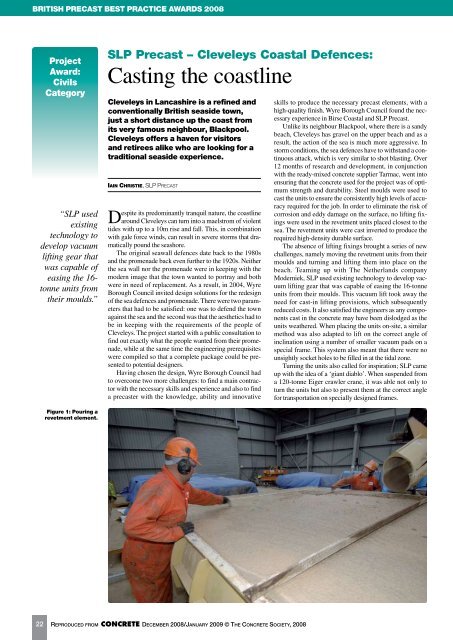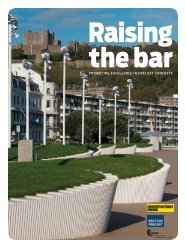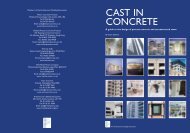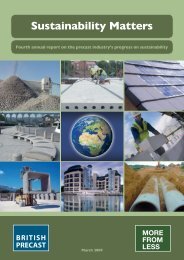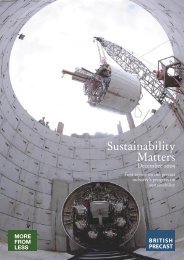The voice of concrete products - British Precast
The voice of concrete products - British Precast
The voice of concrete products - British Precast
You also want an ePaper? Increase the reach of your titles
YUMPU automatically turns print PDFs into web optimized ePapers that Google loves.
BRITISH PRECAST BEST PRACTICE AWARDS 2008<br />
Project<br />
Award:<br />
Civils<br />
Category<br />
“SLP used<br />
existing<br />
technology to<br />
develop vacuum<br />
lifting gear that<br />
was capable <strong>of</strong><br />
easing the 16-<br />
tonne units from<br />
their moulds.”<br />
SLP <strong>Precast</strong> – Cleveleys Coastal Defences:<br />
Casting the coastline<br />
Cleveleys in Lancashire is a refined and<br />
conventionally <strong>British</strong> seaside town,<br />
just a short distance up the coast from<br />
its very famous neighbour, Blackpool.<br />
Cleveleys <strong>of</strong>fers a haven for visitors<br />
and retirees alike who are looking for a<br />
traditional seaside experience.<br />
Iain Christie, SLP <strong>Precast</strong><br />
Despite its predominantly tranquil nature, the coastline<br />
around Cleveleys can turn into a maelstrom <strong>of</strong> violent<br />
tides with up to a 10m rise and fall. This, in combination<br />
with gale force winds, can result in severe storms that dramatically<br />
pound the seashore.<br />
<strong>The</strong> original seawall defences date back to the 1980s<br />
and the promenade back even further to the 1920s. Neither<br />
the sea wall nor the promenade were in keeping with the<br />
modern image that the town wanted to portray and both<br />
were in need <strong>of</strong> replacement. As a result, in 2004, Wyre<br />
Borough Council invited design solutions for the redesign<br />
<strong>of</strong> the sea defences and promenade. <strong>The</strong>re were two parameters<br />
that had to be satisfied: one was to defend the town<br />
against the sea and the second was that the aesthetics had to<br />
be in keeping with the requirements <strong>of</strong> the people <strong>of</strong><br />
Cleveleys. <strong>The</strong> project started with a public consultation to<br />
find out exactly what the people wanted from their promenade,<br />
while at the same time the engineering prerequisites<br />
were compiled so that a complete package could be presented<br />
to potential designers.<br />
Having chosen the design, Wyre Borough Council had<br />
to overcome two more challenges: to find a main contractor<br />
with the necessary skills and experience and also to find<br />
a precaster with the knowledge, ability and innovative<br />
skills to produce the necessary precast elements, with a<br />
high-quality finish. Wyre Borough Council found the necessary<br />
experience in Birse Coastal and SLP <strong>Precast</strong>.<br />
Unlike its neighbour Blackpool, where there is a sandy<br />
beach, Cleveleys has gravel on the upper beach and as a<br />
result, the action <strong>of</strong> the sea is much more aggressive. In<br />
storm conditions, the sea defences have to withstand a continuous<br />
attack, which is very similar to shot blasting. Over<br />
12 months <strong>of</strong> research and development, in conjunction<br />
with the ready-mixed <strong>concrete</strong> supplier Tarmac, went into<br />
ensuring that the <strong>concrete</strong> used for the project was <strong>of</strong> optimum<br />
strength and durability. Steel moulds were used to<br />
cast the units to ensure the consistently high levels <strong>of</strong> accuracy<br />
required for the job. In order to eliminate the risk <strong>of</strong><br />
corrosion and eddy damage on the surface, no lifting fixings<br />
were used in the revetment units placed closest to the<br />
sea. <strong>The</strong> revetment units were cast inverted to produce the<br />
required high-density durable surface.<br />
<strong>The</strong> absence <strong>of</strong> lifting fixings brought a series <strong>of</strong> new<br />
challenges, namely moving the revetment units from their<br />
moulds and turning and lifting them into place on the<br />
beach. Teaming up with <strong>The</strong> Netherlands company<br />
Moderniek, SLP used existing technology to develop vacuum<br />
lifting gear that was capable <strong>of</strong> easing the 16-tonne<br />
units from their moulds. This vacuum lift took away the<br />
need for cast-in lifting provisions, which subsequently<br />
reduced costs. It also satisfied the engineers as any components<br />
cast in the <strong>concrete</strong> may have been dislodged as the<br />
units weathered. When placing the units on-site, a similar<br />
method was also adapted to lift on the correct angle <strong>of</strong><br />
inclination using a number <strong>of</strong> smaller vacuum pads on a<br />
special frame. This system also meant that there were no<br />
unsightly socket holes to be filled in at the tidal zone.<br />
Turning the units also called for inspiration; SLP came<br />
up with the idea <strong>of</strong> a ‘giant diablo’. When suspended from<br />
a 120-tonne Eiger crawler crane, it was able not only to<br />
turn the units but also to present them at the correct angle<br />
for transportation on specially designed frames.<br />
Figure 1: Pouring a<br />
revetment element.<br />
22<br />
Reproduced f ro m CONCRETE December 2008/January 2009 © <strong>The</strong> Concrete So c i e t y, 2008


